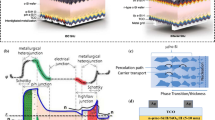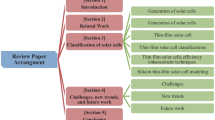Abstract
The effects of indium tin oxide (ITO) film annealing temperature on the performance of organic solar cells are investigated. The roughness of the ITO film surface morphology increased with increasing annealing temperature. The optical penetration and rate of exciton generation both increased with increasing ITO film annealing temperature, enhancing the short-circuit current density. The maximum efficiency (2.62 %) was obtained with an annealing temperature of about 500 °C. The incident-photon-to-current efficiency value for a hybrid photovoltaic device with an ITO film annealed temperature at 500 °C was 45 % at 475 nm.







Similar content being viewed by others
References
Alam MJ, Cameron DC (2000) Optical and electrical properties of transparent conductive ITO thin films deposited by sol-gel process. Thin Solid Films 377–378:455–459
Dennler G, Scharber MC, Brabec CJ (2009) Polymer fullerene bulk hetero junction solar cells. Adv Mater 21:1323–1338
Digital Instrument (1996) Reference manual for nanoscope III. Santa Barbara
Fong CS (2001) Transparent and conductive multi-component oxide thin films prepared by magnetron sputtering. Master Thesis, National University of Singapore
Gan Y, Liu J, Zeng LS (2006) Transparent conductive indium tin oxide film fabricated by dip-coating technique from colloid precursor. Surf Coat Technol 201:25–29
Guillén C, Herrero J (2007) Structure, optical, and electrical properties of indium tin oxide thin films prepared by sputtering at room temperature and annealed in air or nitrogen. J Appl Phys 101:073514
Habak HD, Bergeret C, Cousseau J, Nunzi JM (2011) Improving the current density Jsc of organic solar cells P3HT:PCBM by structuring the photoactive layer with functionalized SWCNTs. Sol Energy Mater Sol Cells 95:53–56
Hsiao YJ, Fang TH, Ji LW (2010) Synthesis and luminescent properties of ZnNb2O6 nanocrystals for solar cell. Mater Lett 64:2563–2565
Kikuchi N, Kusano E, Nanto H, Kinbara A, Hosono H (2000) Phonon scattering in electron transport phenomena of ITO films. Vacuum 59:492–499
Kim SS, Choi SY, Park CC, Jin HW (1999) Transparent conductive ITO thin films through the sol-gel process using metal salts. Thin Solid Films 347:155–160
Lee SW, Lee HJ, Choi JH, Koh WG, Myoung JM, Hur JH, Park JJ, Cho JH, Jeong U (2010) Periodic array of polyelectrolyte-gated organic transistors from electrospun poly(3-hexylthiophene) nanofibers. Nano Lett 10:347–351
Li TL, Hsu SLC (2007) Preparation and properties of a high temperature, flexible and colorless ITO coated polyimide substrate. Eur Polymer J 43:3368–3373
Li G, Shrotriya V, Huang JS, Yao Y, Moriarty T, Emery K, Yang Y (2005) High-efficiency solution processable polymer photovoltaic cells by self-organization of polymer blends. Nat Mater 4:864–868
Liang Y, Xu Z, Xia J, Tsai ST, Wu Y, Li G, Ray C, Yu L (2010) For the bright future-bulk heterojunction polymer solar cells with power conversion efficiency of 7.4 %. Adv Mater 22:E135–E138
Ma WL, Yang CY, Gong X, Lee K, Heeger AJ (2005) Thermally stable, efficient polymer solar cells with nanoscale control of the interpenetrating network morphology. Adv Funct Mater 15:1617–1622
Major S, Banerjee A, Chopra KL (1983) Highly transparent and conducting indium-doped zinc oxide films by spray pyrolysis. Thin Solid Films 108:333–340
Park SH, Roy A, Beaupré S, Cho S, Coates N, Moon JS, Moses D, Leclerc M, Lee K, Heeger AJ (2009) Bulk heterojunction solar cells with internal quantum efficiency approaching 100 %. Nat Photonics 3:297–302
Raoufi D, Kiasatpour A, Fallah HR, Rozatian ASH (2007) Surface characterization and microstructure of ITO thin films at different annealing temperatures. Appl Surf Sci 253:9085–9090
Shaheen SE, Ginley DS, Jabbour GE (2005) Organic-based photovoltaic: toward low-cost power generation. Mater Res Bull 30:10–15
Terzini E, Thilakan P, Minarini C (2000) Properties of ITO thin films deposited by RF magnetron sputtering at elevated substrate temperature. Mater Sci Eng B 77:110–114
Valls IG, Cantu ML (2009) Vertically-aligned nanostructures of ZnO for excitonic solar cells: a review. Energy Environ Sci 2:19–34
Zhang J, Au KH, Zhu ZQ, O’Shea S (2004) Sol–gel preparation of poly(ethylene glycol) doped indium tin oxide thin films for sensing applications. Opt Mater 26:47–55
Acknowledgments
The authors would like to thank the National Science Council of Taiwan for financially supporting this research under contracts NSC 99-2221-E-492-023 and NSC 100-2628-E-151-003-MY3.
Author information
Authors and Affiliations
Corresponding author
Rights and permissions
About this article
Cite this article
Wang, SH., Hsiao, YJ., Fang, TH. et al. Effects of ITO film annealing temperature on hybrid solar cell performance. Microsyst Technol 20, 1181–1185 (2014). https://doi.org/10.1007/s00542-013-1910-0
Received:
Accepted:
Published:
Issue Date:
DOI: https://doi.org/10.1007/s00542-013-1910-0




